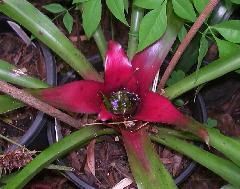
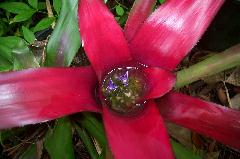
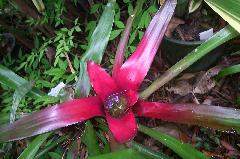
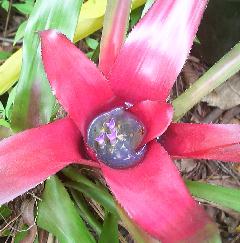
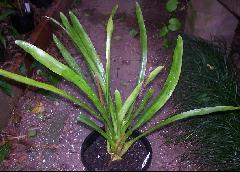
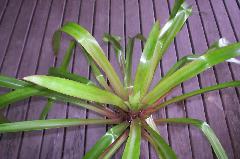
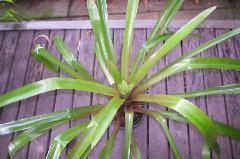
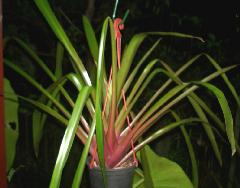
| Ian Hook, Sydney 08/03, BSA unpotted sale 08/03. |
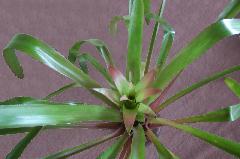
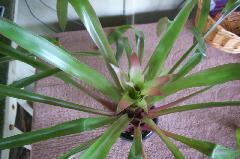
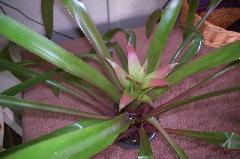
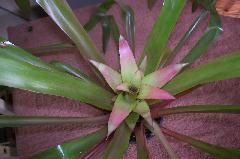
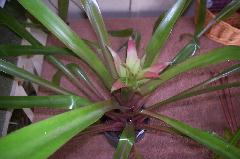
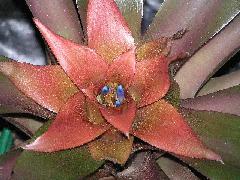
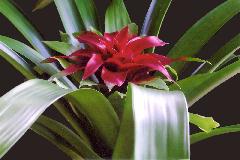
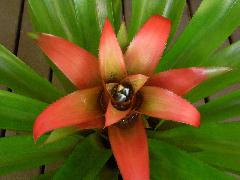
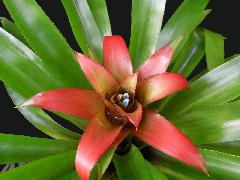
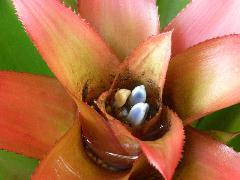
PLANT quite variable in size and conformation.
LEAVES 15 to 20, suberect to subspreading, subrigid, forming a tunnelform rosette;
SHEATHS elliptic, 11-20 x 4-8 cm, greenish to purplish, densely brown-lepidote;
BLADES sublinear, slightly narrowed toward base, 30-120 x 3-4 cm, green or reddish-purple, sparsely and inconspicuously lepidote, apex short- to long-acuminate, margins densely and minutely spinulose, spines 0.5-1 mm long, 2-4 mm apart.
SCAPE 5-30 cm long, 0.6-1 cm in diameter, shorter to distinctly exceeding the leaf sheaths;
SCAPE BRACTS the basal ones foliaceous and exceeding the inflorescence, the upper ones subfoliaceous.
INFLORESCENCE bipinnate, long-stellate at apex, 6-7 cm long, 15-20 cm in diameter at apex, from nidular to distinctly elevated above the rosette;
PRIMARY BRACTS 12-22 cm long, sheaths distinct, suborbicular, 5-6 x 6- 7 cm, blades narrowly triangular-lanceolate, 2.5-3 cm wide at base, apex acuminate, spreading-recurved, variably colored, usually green near the base and red or pink toward apex, inconspicuously lepidote, densely spinulose toward apex with spines ca. 1 mm long;
FASCICLES ca. 10, the lower ones 4-to-7-flowered, 40-45 x 25-30mm;
FLORAL BRACTS narrowly ovate-lanceolate, apex acute and apiculate, 20-40 x 8-15 mm, typically sub densely to very densely and distinctly spinulose at apex, spines irregularly curved, sparsely brown-lepidote, greenish near the apex, hyaline elsewhere, about equaling 1/2 to 2/3 sepal length.
FLOWERS subsessile or rarely short-pedicellate, pedicels 2-3 mm long, 55-65 mm long;
SEPALS narrowly elliptic to ovate-elliptic, apex acute to subacute and minutely apiculate, 20-25 (-30) x 5-8 mm, connate for 5-8 mm, glabrescent, green;
PETALS 35-40 mm long, connate for 25-30 mm, tube white, lobes ca. 10 x 6 mm, pale blue to dark blue with white margins toward apex and somewhat lilac toward base, bearing 2 inconspicuous callosities at base;
ANTHERS 7 mm long, apex distinctly apiculate;
STIGMA broadly ellipsoid, blades with margins minutely crenulate;
OVARY ellipsoid to subclavate, 15-25 mm long, 5-7 mm in diameter, typically purplish toward base.
FRUITS the basal 2/3 lilac, the apical 1/3 dark brown, persistent calyx white on the sepal keels in contrast to the purple margins, base dark brown.
TYPE Sander s. n, fl. cult. Oct. 1882 in Liege Hortus. Holotype. LG.
ETYMOLOGY
The name of this species comes from the Latin procerus meaning "tall" or "elegant" and referring to the inflorescence that is usually raised well above the leaf rosette.
DISCUSSION
In October 1882, a specimen flowered in Edouard Morren's greenhouse that had been introduced into cultivation by Sander, an ornamental plant merchant from St. Alban, England (Baker, 1889). Morren depicted the specimen in a painting and called it Canistrum purpureum. It was then pressed and dried and is today deposited in the herbarium of the Botanic Garden at the University of Liege, in Belgium. It is made up of three leaves and an inflorescence, and has the following inscription in Morren's handwriting: "Canistrum purpureum, Sander, Oct. 1882". The following year, Morren announced this name in the publication La Belgique Horticole together with Canistrum fuscum (= Edmundoa lindenii var. rosea), both cited as yet unpublished species and no description or plate was published. Inspired by Canistrum purpureum, Baker (1889) then published Aechmea purpurea and described it on the basis of Morren's painting, but he did not have the opportunity to examine the corresponding herbarium sheet in Liege.
In February 1891, Karl Axel Magnus Lindman reestablished the correct generic placement of the taxon. Since he knew that Nidularium purpureum Beer had been published in 1856, Lindman explicitly proposed a new name, Nidularium procerum, to substitute Canistrum purpureum and Aechmea purpurea which he placed in synonymy. He based his work on a specimen collected by Mosen (3706) in Santos, Sao Paulo. This specimen was designated as the type of N. procerum by Smith & Downs (1979). However, according to Art. 7.3 of the Tokyo Code (Greuter et al. 1994), the nomen novum in this case N. procerum, is typified on the basis of the oldest name. Therefore, N. procerum would correctly be typified based on Sander's specimen (LG) and the respective painting by Morren, cited Baker (1889), that belongs to the collection of the Royal Botanic Gardens (K).
In November 1891, Karl Mez published Nidularium porphyreum as another new name for Aechmea purpurea, in this case superfluous because it was outdated by Lindman's proposal published months earlier. Mez (1891) cited a specimen collected by Glaziou ( 15490) at Serra da Bica (the type locality of N. angustifolium) and mentioned that he had seen the live specimen, cultivated by Morren, in the gardens at Liege. Actually, Mez examined the specimen Sander s. n. and identified it in writing as "Nidularium porphyreum" on the herbarium sheet. Mez (1935) himself included N. porphyreum as a synonym of N. procerum.
Nidularium terminale, published in 1898, is considered here to be a new synonym of N. procerum. It was described by Ule from plants that he had collected at altitudes of 600 to 800 m in the Serra da Tijuca, Rio de Janeiro.
Although the holotype has disappeared and the isotype at the National Museum, Rio de Janeiro, consists only of leaves, the species was well defined in the protologue by a meticulous description. This taxon represents populations of N. procerum that are found in Tijuca National Park, Rio de Janeiro, and in some mountainous areas of Espirito Santo. The inflorescence of plants from these populations is raised well above the leaf rosette, but it is more compact and has pale pink primary bracts. Without exception, the remainder of the characteristics are totally compatible with those described for N. procerum.
In 1919, Mez described N. affine based on a live specimen (probably collected by Ule) from the gardens of the Berlin Dahlem Botanical Museum. The holotype of N. affine deposited in the herbarium of this institution, is composed of two exsiccata. The first is an almost entire specimen that flowered on December 2, 1910, and was initially identified as N. angustifolium. Mez himself, wrote the inscription "Nidulariurn affine n. sp. 1919" on the herbarium sheet. The same inscription appears also on the second sheet made up of four leaves and two longitudinal sections of the inflorescence of a more delicate specimen than that of the first herbarium sheet. Smith (1955) had correctly listed N. affine as a synonym of N. procerum since the morphological details of these two taxa coincide.
Ule (1898) was the first author to attribute N. kermesianum to Fritz Muller but he did not provide enough information to allow recognition of the taxon. Only in 1934 did Mez validly publish this taxon, and he also attributed it to F. Muller, based on a plant grown by F. Muller himself that originated in Blumenau, Santa Catarina. The holotype is deposited in the Berlin-Dahlem Botanical Museum and consists of one leaf, two halves of an inflorescence cut lengthwise and one primary bract. According to the protologue, this would be a distinct species because of its reddish wine leaves and primary bracts and because of the inflorescence not distinctly raised above the leaf rosette.
Reitz (1952) lowered the status of N. kermesianum to that of a variety of N. procerum, stressing its smaller number of reddish wine-colored leaves and dingy greenish blue petals. This last characteristic is written on the label of the holotype (“flores sordide virenti-coerulis"). The differences listed by Reitz and by Mez (1934) fall within the limits of normal morphological variation adopted here for N. procerum. The reddish wine leaves are a common phenomenon in this genus (see chapter 1), the rather nidular inflorescence is found in several different populations and the leaf- and floral-rosette configuration also varies in this species. The dingy greenish blue petals are within the limits of color variation in this taxon where the corollas may be dark blue to light blue or bluish gray, usually with white apical margins, or sometimes with a slightly greenish tone. Likewise, wine-colored leaves are found as commonly in plants with a nidular inflorescence as they are in those with the inflorescence raised well above the leaf rosette, and so there is no correlation between these traits.
Carlos Stellfeld created Nidularium uleanum in 1956 as a new name for Ule's N. terminale. Stellfeld erroneously concluded that Tillandsia terminalis Vell. (= Canistropsis billbergioides forma azurea), and not Hohenbergia billbergioides Schultes f., should be the basionym of Nidularium billbergioides (Leme, 1998). He then proposed a new combination, N. terminale (Vell.) Stellfeld, and created N. uleanum to substitute Ule's homonym N. terminale, here considered a synonym of N. procerum.
Finally, the most recently published synonyms of N. procerum proposed in this study are N. insularis and N. gracile. The first taxon, collected on an island in Angra dos Reis municipality, merely represents a variation of N. procerum with a more or less nidular inflorescence that occurs along the coast from Angra dos Reis and Parati to Ubatuba. On the other hand, N. gracile represents populations that are mainly epiphytic and therefore have a more delicate configuration, with all leaf and flower parts slightly smaller than those of terrestrial specimens of N. procerum, but with no relevant differences in relation to this taxon. Live specimens from the type locality collected by the author of the species were studied here. Plants vegetatively equivalent to N. gracile are often seen mixed with populations of more robust individuals in Rio de Janeiro, Sao Paulo, Parani and Santa Catarina.
Nidularium procerum is without a doubt the most problematic species of the genus. Its apparent polymorphism confounds the conceptualization of the species and, as a result, makes the task of defining closely related taxa very difficult. Very few species that are closely linked to N. procerum could be truly differentiated trom it in this study (e. g., N. angustifolium, N. viridipetalum, N. serratum). Its wide geographic distribution trom Bahia to Rio Grande do Sul, in several altitudinal zones, probably contributes to greater phenotypic variation. As a general rule, according to Futuyma (1997), the farther apart the populations, the greater the differences between them in allele frequencies and in genetically based phenotypic traits. On the other hand, it should be remembered that we might be dealing with a complex of species that differ subtly in cryptic morphological characteristics still not totally understood, and not just a single polymorphic species.
In the absence of an abundance of information on the biology of each divergent N. procerum population, I opted for a nore flexible concept of the species. However, I do not see this concept as ideal. In the first place, it reflects a transient inability to fully understand this species (or superspecies) or to classify it in several different taxa based on solid criteria, without affecting nomenclatural stability For the same reason, I discarded the possibility of creating infraspecific categories to represent this variation. Dozens of subspecies, varieties or forms would be necessary to express this variation coherently and this would, in large part, be artificial, arbitrary and practically unsubstantiated.
Broadly speaking, N. procerum can be briefly characterized by the following suite of characteristics: leaves more or less rigid in texture, densely spinulose, with spines up to 1 mm long, inflorescence bipinnate, from nidular to raised well above the leaf rosette, with primary bracts usually red, spreading-recurved, floral bracts densely and distinctly spinulose at the apex, sepals elliptic to ovate-elliptic, acute or subacute, petals variously blue-colored, ovary purple-lilac towards the base, fruits with the basal 2/3 purple-lilac and persistent calyx with sepals having obtuse protruding keels, whitish, contrasting with the purple margins. The most pronounced variation is related to floral-scape length that determines how far the inflorescence is raised above the leaf rosette, plus inflorescence diameter and bract color.
In the most common contlguration of N. procerum, the leaf blades are totally green, the scape clearly exceeds leaf-sheath length and the inflorescence is raised well above the leaf rosette, with bracts that are tinged various tones of red. Populations with purplish-wine leaves are more common in Parani and Santa Catarina, corresponding in part to N. kermesianum. The inflorescence is nidular in several populations. In populations from coastal Rio de Janeiro and Sao Paulo, specimens with the N. insularis pattern are found, that is, robust plants with larger inflorescence diameters, primary bracts red toward the apex and pale blue petals. In the same area there are also populations of more delicate plants, with smaller inflorescence diameters and primary bracts totally red, a pattern that resembles, in part, N. kermesianum. This same pattern is seen in Espirito Santo where populations with lovely reddish purple primary bracts and slightly smaller sepals are found. The floral bracts of these populations vary from almost entire to densely spinulose. This variation, however, was also observed in populations with a pattern equivalent to that of N. terminale, that is, with a more compact inflorescence raised well above the leaf rosette and pale pink bracts. These populations are found from the city of Rio de Janeiro northward to Espirito Santo and into Bahia.
DISTRIBUTION & HABITAT
Nidularium procerum has the widest geographic distribution of the genus, followed by N. innocentii. It ranges from Bahia, where it is found even at the western limit of the Atlantic forest, in Wenceslau Guimaraes municipality, to southern Brazil, passing the "Torres gateway" in Santa Catarina and penetrating into the state of Rio Grande do Sul, where it is much rarer. This species follows the Atlantic forest down the coast, invading transitional areas with associated formations such as mangroves and restingas.
It grows from sea level to nearly 1,000 m altitude, sometimes forming large terrestrial populations or growing in isolated patches on rocks or as an epiphyte in the lower layer of the forest. Populations have even been reported from permanently flooded areas (see chapter 1).
Nidularium procerum is found growing in several public conservation units throughout its range. It has two distinct flowering periods. Typical of the genus, it flowers in the rainy season, from November to March, or it may also flower from July to September. There are many clones in cultivation, including those that are direct descendents of the type specimens of the taxa that were placed in synonymy here.
Nidularium insularis E. Pereira & Leme, Bradea 4 (11): 71, fig. 3. 1984.
PLANTA terrestris, florifera circa 90 cm alta, breviter stolonifera foliis c. 40 rosulatis, basi utriculum infundibuliformem formantibus. FOLIA c. 90 cm longs, ligulata subcoriacea; VAGINIS ellipticis c. 15 cm longis, 8 cm latis, interne purpurascentibus, externe viridibus, utrimque dense brunneo-lepidotis; LIMBIS c. 75 cm longis latitudine ut maxima 4 cm, utrimque viridibus atque inconspicuis lepidotis, basim versus leviter angustatis, apicem versus sensim angustatis in spinam ad 5 mm longam desinentibus; MARGINE spinis minutis sursum rectis haud ultra 1 mm longis dense armata. SCAPUS circa 9 cm longus, in vivo 10 mm diamet., rigidus, sulcatus, glaber, vaginis foliorum obtectus; BRACTEIS SCAPALIBUS duabus foliaceis scapum haud occultantibus sed inflorescentiam superantibus. INFLORESCENTIA inter folia intima nidulans leviter exserta; BRACTEIS PRIMARIIS circa 16 ovatis, externae 9 cm longae, 8 cm latae, limbo anguste triangulari 15 cm longo spinam 5 mm longam.desinentes, minute serrulato, utrimque purpurascente atque inconspicue lepidoto, circa 5 x flores superantibus, internae non plus 2 x longitudinem florum; BRACTEIS FLORIFERIS circa 40 mm longis, 17 mm latis, lanceolatis apice spinulosis, prope apice spinis irregulariter curvatis, percarinatis, percurvatis, utrimque sparse lepidotis, viridibus, sepalis altitudinem aequantibus. FLORES c. 50 mm longi inconspicue pedicellati; SEPALIS oblongis 25 mm longis, 9 mm latis, apice obtusis atque mucronulatis, viridibus, glabris, obtuse carinatis, basi 6 mm connatis; PETALIS basi in tubum ad 25 mm longum, album, connatis, lobis 12 mm longis, dilute azureis, apice rotundatis; STAMINIBUS inclusis filamentis in tota longitudinem tubo adnatis; OVARIO trigono 15 mm longo, albo; TUBO EPIGYNO 2 mm longo; PLACENTIS fere a basi usque ad apicem loculorum affixis; OVULIS obtusis.
TYPUS: Estado do Rio de Janeiro, Municipio de Angra dos Reis, Ilha de Paqueta. Ocorre sobre o solo, em formacoes, protegida por vegetacao arbustiva. Leg. Elton M.C. Leme no 550, em janeiro de 1984. Florida em cultivo em 10 de Junho de 1984. HOLOTYPUS HB, ISOTYPUS RB.
Esta especie fica proxima da N. procerum Lindman e da N. terminale Ule. Entretanto, difere de ambas por possuir, entre outras caracteristicas, escapo mais curto, nao ultrapassando a altura das bainhas das folhas alem de bracteas florais igualando a altuna das sepalas e sepalas oblongas.
This new species resembles the N. procerum Lindman and N. terminale Ule. But it differs from both mainly because of the presence of shortly scape, surpassed by leaf-sheaths, besides its floral bracts equaling the oblong sepals.
Nidularium gracile Tardivo Bromelia 2 (2).29, 30 (fig.), 31 (photo) 1995
Nidularium gracile Tardivo proximum N. antoineanum Wawra et N. procero Lindman, scapo florali vaginas foliorum distincte superanti et lobis corollae caerulei; tamen a speciebus ambabus facile distinguitur foliis basin versus conspicue angustatis, bracteis floralibus anguste triangularibus apicem versus dense conspicueque serratis, spinis irregulariter recurvatis. Distinguitur haec nova species quoque a N. antoneano apice foliorum acuminato et a N. procero foliis ad marginem medianum subconfertim serratis, inflorescentia gracili, ad basin non ultra 10cm diametro, bracteis primariis 7 - 8,5cm longis etiam floribus minoribus usque 4.8cm longis.
TYPE: Parana, Estrada Velha Curitiba-Joinvile, proximo ao km 76, Rio Sao Joao; 15 de fevereiro de 1994, R. C. Tardivo et al. 140. Holotypus. UPCB. Isotypus: UPCB.
PLANT 4,5cm tall, epiphytic, rupiculous or terrestrial.
LEAVES 20-25, suberect, rosulate;
SHEATHS 7,5-12cm long, 2,8-5,5cm wide, elliptic, dark brown-lepidote and with irregular purple spots on both sides but mainly abaxially;
BLADES ca. 85cm long, 1,8 - 3cm wide, narrowly linear, distinctly narrowed toward base, apex acuminate, green, margins subdensely serrulate, spines 0,5-1 mm long, ca. 4mm apart, becoming denser near the apex, dark brown-lepidote on both sides.
SCAPE ca. 15cm long, 5- 7,5mm diam., erect, whitish, becoming greenish toward the inflorescence, glabrous.
SCAPE BRACTS 2, foliate, whitish at base and green toward the apex, densely serrulate.
INFLORESCENCE 9-9,5cm long, obovate.
PRIMARY BRACTS oval-lanceolate, acuminate, 4-8,5cm long, ca. 3cm wide at base, sub-erect or the apex recurvate, margins serrulate, spines ca. 0,5mm long, lepidote on both sides, salmon-pink at apex and greenish to whitish toward base.
BRANCHES ca. 6, with 2-5 flowers, subsessile, flabellate, the basal ones 4,8cm long, 1-2cm wide, the upper ones 5cm long, 2,2cm wide.
FLORAL BRACTS narrowly triangulate, 2-3cm long, 0,6-1 cm wide, carinate, densely and conspicuously serrulate toward apex, pale brown-lepidote on both sides, apex acute or apiculate, slightly recurved.
FLOWERS subsessile, 3,5-4,8cm long.
SEPALS elliptic, symmetric, 1,4-2cm long, 1,5cm wide, connate at base for 0,5cm, whitish, obtusely carinate, apex subacute.
PETALS ca. 3cm long, conn.ate at base for 2-2,3cm, whitish at base, lilac toward apex, lobes completely blue, apex obtuse-cucullate, bearing tenuous calluses at the base of the lobes.
STAMENS included.
ANTHERS 0,7 -0,8cm long, linear, base obtuse, apex mucronulate, dorsifixed at middle.
OVARY trigonous, glabrous, bluish, ca. 0,8cm long, ca. 0,5cm wide.
PLACENTAE axial, rudimentary
SEEDS obovate
Additional material examined. Parana, Estrada Velha Curitiba-Joinvile, proximo ao km 76, Rio Sao Joao; 1 de maio de 1994, R. C. Tardivo et al 167 (UPCB).
Etymology. Thc species name comes from thc Latin gracilis which means delicate and refers to the fragile appearance of the inflorescence.
Detail from S&D
21. Nidularium procerum Lindman, Sv. Vet-akad. Handl. 24(8): 16, pl. 1, figs. 1-7. Feb. 1891.
Leaves 12-40 in a dense rosette; sheaths large, oblong-elliptic, entire, usually tinged with purple, covered with minute appressed brown-centered scales; blades ligulate, acute or acuminate, slightly if at all narrowed toward base, wholly green, glabrous or subglabrous, subdensely serrate with spines 1 mm long. Scape always evident, to over 20 cm high; scape-bracts foliaceous, very densely imbricate. Inflorescence rather many-flowered; primary bracts very broadly ovate with a narrowly triangular long attenuate serrulate blade, purple or red toward apex, green toward base, much exceeding the flowers. Floral bracts ovate or elliptic, acute, slightly exceeding the ovary, carinate, membranaceous, serrulate toward apex, pale, sparsely lepidote; flowers to 7 cm long. Sepals symmetric or nearly, elliptic, acute, minutely mucronulate, 23 mm long, connate for 5-6 mm, glabrous; petals connate to within 20 mm of the apex, pale blue; ovary ellipsoid, epigynous tube evident, placentae continuous nearly the whole height of the cell; ovules obtuse.
Key to Varieties of Nidularium procerum
1. Leaves 4-10 dm long, the blades 2-5 cm wide. 21a. var procerum.
1. Leaves up to 4 dm long, not over 3 cm wide. 21b. var kermesianum.
21a. Nidularium procerum var procerum Fig 530 D-F.
Canistrum purpureum E. Morren, Belg. Hortic. 33: 195. 1883; nomen.
Aechmea purpurea Baker, Handb. Bromel. 69. 1889. Type: Morren Icon (K). Non Nidularium purpureum Beer, 1856.
Nidularium porphyreum Mez, Mart. Fl. Bras. 3(3): 219. Nov 189 1. Nom. nov.
Nidularium angustifolium Ule, Ber. Deutsch. Bot. Ges. 16: 351. 1898. Type. Ule 4039 (B, F photo 11268), Cascadura, Guanabara, Brazil, July 1896.
Nidularium affine Mez, Repert. Sp. Nov. Fedde 16: 4. 1919. Type. Berlin Hortus (B, F photo 11267).
Karatas cardinalis Edinburg Hortus ex Mez in Pflanzenreich IV. 32: 61 1934; nomen.
Leaves 4-10 dm long, the blades 2-5 cm wide.
Type. Mosen 3706 (holotype S, isotype US), Santos, Sao Paulo, Brazil, 15 Apr 1875.
Distribution. Terrestrial and epiphytic in low forest, sea level to ca. 1300 m alt, Espirito Santo to Rio Grande do Sul, Brazil.
21b. Nidularium procerum var kermesianum (Fritz Muller ex Mez) Reitz, Anais Bot. Herb. Barbosa Rodrigues 4: 18. 1952.
Nidularium kermesianum Fritz Muller ex Mez, Engl. Pflanzenreich IV. 32: 62. 1934.
Leaves up to 4 dm long, not over 3 cm wide.
Type. Fritz Miller s n (holotype B, B photo 1195/27), Blumenau, Santa Catarina, Brazil.
Distribution. Epiphytic in low forest, sea level to 900 m alt, Parana and Santa Catarina, Brazil.
18. Nidularium terminale Ule, Ber. Deutsch. Bot. Ges. 16: 348, pl. 22, fig. 2-5. 1898. Leaves 20-30 in a dense rosette, erect, to 1 m long; sheaths ovate-elliptic, large, entire, often maculate, lepidote beneath with minute gray-brown scales; blades ligulate, broadly acute and apiculate, 5-6 cm wide, coriaceous, rigid, subglabrous, dark brownish-green especially beneath, densely serrate with antrorse curved spines 0.5 mm long, concolorous; scape 30-50 cm high, glabrous; scape-bracts few, like the primary bracts and massed at the top of the scape. Inflorescence compound, rather many-flowered; primary bracts broadly ovate or suborbicular with a lanceolate blade, to 14 cm long, completely concealing the flowers, rose-purple, densely serrate with stout antrorse curved spines, ending in a stiff spine, glabrous. Floral bracts ovate-elliptic, acute, covering the lower third or quarter of the sepal, serrulate toward apex, carinate, membranaceous, sparsely lepidote; flowers sessile, ca. 6 cm long. Sepals subsymmetric, ovate-elliptic, acute, mucronulate, 23 mm long, connate for 8 mm, pale green, glabrous; petals ca. 4 cm long, high-connate, obtuse, pale blue, drying whitish; stamens included; ovary subovoid, glabrous.
Type. Ule 4162 e. p. (holotype B, isotype R), Tijuca, Guanabara, Brazil.
Distribution. Known from the type collection only.